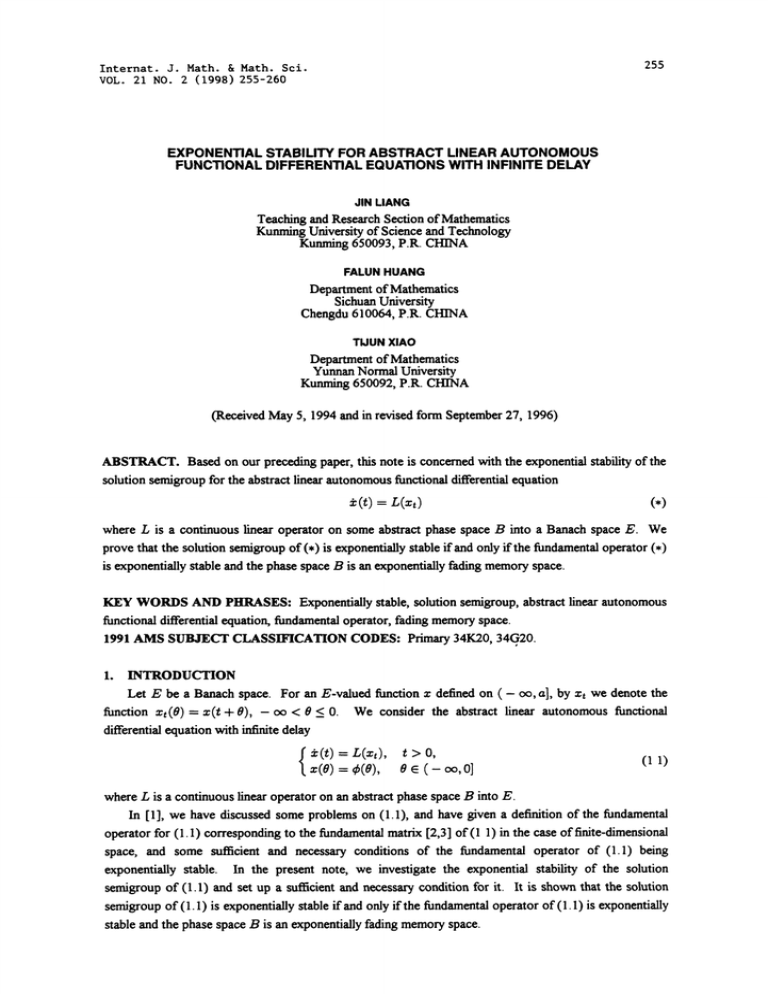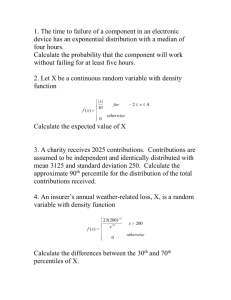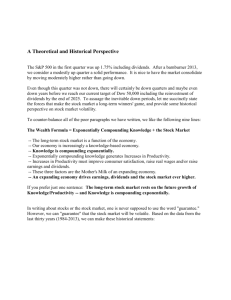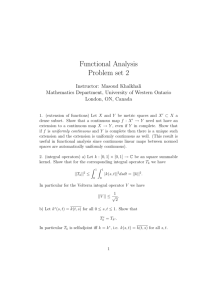DELAY EXPONENTIAL STABILITY FOR ABSTRACT LINEAR AUTONOMOUS INFINITE
advertisement

255
Internat. J. Math. & Math. Sci.
VOL. 21 NO. 2 (1998) 255-260
EXPONENTIAL STABILITY FOR ABSTRACT LINEAR AUTONOMOUS
FUNCTIONAL DIFFERENTIAL EQUATIONS WITH INFINITE DELAY
JIN LIANG
Teaching and Research Section of Mathematics
Kunming University of Science and Technology
Kunming 650093, P.R. CHINA
FALUN HUANG
Department of Mathematics
Sichuan University
Chengdu 610064, P.R. CHINA
TIJUN XIAO
Department of Mathematics
Yunnan Normal University
Kunming 650092, P.R. CHINA
(Received May 5, 1994 and in revised form September 27, 1996)
ABSTRACT. Based on our preceding paper, this note is concerned with the exponential stability of the
solution semigroup for the abstract linear autonomous functional differential equation
,(t)
L(x)
(,)
where L is a continuous linear operator on some abstract phase space B into a Banach space E. We
prove that the solution semigroup of (,) is exponentially stable if and only if the fundamental operator (,)
is exponentially stable and the phase space B is an exponentially fading memory space.
KEY WORDS AND PHRASES: Exponentially stable, solution semigroup, abstract linear autonomous
functional differential equation, fundamental operator, fading memory space.
1991 A.MS SUBJECT CLASSIICATION CODES: Primary 34K20, 34G,20.
INTRODUCTION
oo, a], by xt we denote the
Let E be a Banach space. For an E-valued function x defined on
oo < 0 < 0. We consider the abstract linear autonomous functional
function xt(O) x(t + 0),
differential equation with infinite delay
1.
(t)
(o)
L(x), > O,
(0), o (- oo, o]
(1 1)
where L is a continuous linear operator on an abstract phase space B into E.
In [1], we have discussed some problems on (1.1), and have given a definition of the fundamental
operator for (1.1) corresponding to the fundamental matrix [2,3 of (1 1) in the case of finite-dimensional
space, and some sufficient and necessary conditions of the fundamental operator of (1.1) being
exponentially stable. In the present note, we investigate the exponential stability of the solution
semigroup of (1.1) and set up a sufficient and necessary condition for it. It is shown that the solution
semigroup of (1.1) is exponentially stable if and only if the fundamental operator of (1.1) is exponentially
stable and the phase space B is an exponentially fading memory space.
J. LIANG, F. HUANG AND T. XIAO
256
MAIN RESULTS
Let U(Y) be the set of all bounded linear operators from space Y to Y. X[.,,](
denotes the
characteristic function of interval [u, v]. Suppose B is a Banach space of E-valued functions on
2.
oo, 0] with a norm [Is having the following properties:
E, a > r, is continuous on [r, a] and a:0
oo, e]
(HI). If :v
B, then zt is continuous in
[o, ].
KIIII for a in B and some constant K.
I111 / [lll() for any fl > 0, B, where IIl[ -inf{[l[[B "b
fix2). I10)11 <_
(H3). i1[1 _<
,(0) (0) for 0
B and
B and (0) (0) for 0 [-/, 0]}.
-/]}, I111() inf{llll
0-I4). IIll < g sup{ll(0)ll, -/ < 0 < 0} for any e B and some constant Kt; sup [[[[ is
IIl=
a locally bounded function of fl >_ 0.
vth I1()11 -< I1()11 fo
(HS). I1( )lib -< 11( )11 Vo aay
(- oo, 0] ad
oo,
,
some constant M.
and some constant M.
B is called an admissible phase space. (H4) and (HS) stem from (aa), (#) and () in [4]. It is
clear that [1, H(3)] follows from (H4) and (H5). A typical example ofthe space B could be found in [1].
It is iolown that for each
B, the solution :c() c(, q) of(l.1) exists uniqudy for t [0, oo) For
define
B,
every
o),
[0,
(r(t)e(o)
:(o)
,(o, e)
{
(:le, t + o > o,
t + o <_ o,
e(o) +
(t + o),
is called the slution semigroup of (1.1). If L
semigroup, i.e.,
{T(t)}t>_
(s(t))(o)
(o),
+ o > o,
(t + o), t + o _< o,
t
e [o, ,), e
It is also called a translation semigroup. By virtue of (HI),
on B. Set
(s(t)e)(o)
0,
e(t + o),
t+O>O,
+ o <_ o,
O, we denote by
t
,o
o ({S(t)}>_
e
, ol.
the solution
, o].
{T(t)}>_ and {S(t)}_o are 6’0 semigroups
e [o, ),
e
,o
, o].
An admissible phase space B is called to be an exponentially fading memory space, if there
are constants C, a > 0 such that IIS0(t)ll < Ce-tll/,ll for any b B, > 0. By (HI) and
(H6), So(t) B(t > 0). Therefore, B is an exponentially fading memory space if and only if
IISo(t),llB < Ce-tllliB for any b B, > 0 and some positive constants C, a, since by (H5),
IIS0(t)ll, _< IIS0(t)ll _< MllSo(t)ll, for any
B, > 0.
(2.1)
> O,
<_ o,
(.
LEMMA 1. Let z(t, ) be the solution of(1.1). Then
z(t, )
or for 0
e, 0],
x(t)e(o) +
e(t),
x(t- ,-)L(So()e)e,-,
257
EXPONENTIAL STABILITY FOR ABSTRACT LINEAR EQUATIONS
where X(t) is the fundamental operator of (1.1) (see [1 ]).
PROOF. Let
IIT()Ii, IIS(*)IIH_< M", ,_>o,
where M
(2.4)
> 0, r/> a (the constant in 1, Lemma 2.2]) are constants. For b E B, set
v(t)
and z(t)
z(t, cb)
x(t, ok)
0,
v(t, )
t>0
(t), t <_ o,
V(t, ), where x(t, ) is the solution of(1.1). Then we have
dx
d’-- L(z, + So(t)@) Z(zt) + Z(So(t,)cb),
> O.
(2.5)
CEB.
(2.6)
By virtue of (H5) and (2.4), we obtain
IIz, ll, IIS0(t)ll < MzMe"t,
t>0,
Moreover, according to (H2) or (2.5),
IIz(t)ll < M2e",
> 0,
(2.7)
where M2 > 0 is a constant. Thus, taking Laplace transform on two sides of the equality (2.5), we have
that for Re A > r/,
@(0) + A(,)
=/_,(e’)(,) +
e-tI.,(S(t))dt,
that is
(A)
(AI- L(e’’))-Z(O)+
e-’(AI L(e’))-L(So(t))dt,
where "(A) is a Laplace transform of z. Accordingly, the formula (2.2) follows from the definition of
X (t), the convolution property and the uniqueness property of Laplace transform.
THEOREM 1. The solution semigroup {T(t)}t>_o of (1.1) is exponentially stable if and only if the
fundamental operator X(t) of (1.1) is exponentially stable and the phase space B is an exponentially
fading memory phase.
PROOF. Necessity. Let
IlT(t)ll < M0e-’llll
where M0, cr
> 0, @ (5 B,
> 0 are constants. Then, by (1-15)
IIS0(t)ll, IIZ0(t)ll, < IIZ(t)ll < Moe-rllll, t > 0,
that is, B is an exponentially fading memory space.
According to [1, Lemma 3.1], for every b F_. E,
Therefore,
for
X(t)b satisfies
k(t)b
L(Xtb),
X(O)b
xto.ol(O)b, O E (- oo, 0).
>0
(2.8)
B,
(2 9)
258
J. LIANG, F. HUANG AND T. XIAO
(T(t)X[0.0](-)b)(O)lo=o
b+
X(t)b, b E E.
L(XTb)dA
Consequently, it follows from (H2), (2.8) and (H6) that for any b E E,
Ilx(t)bll < KllT(t)X[o.o](" )bll < KMoMe-]]bll, t > O.
This shows that X(t) is exponentially stable.
Sufficiency. Obviously, we can suppose
IIX()ll _< Moe-at(t >_ 0),
IIo(e)ll _< Moe-llll (e > o,
).
Hence, by (H2),
sup IIX(t + e)(O)ll <_
,
-<o<o
[- 0],
Moreover, for 0 e
mo-’ll(o)ll < Mo-lllls.
X(t + 0 r)L(So())dT <
JO
(2.10)
;_t+aMoe-(t+a-’)JlLHMoe-’JllJBdT
JO
Accordingly,
X(t + 0- "r)L(So(’r))dr <
sup
-_<o_<o
M[[L[lte- lllla.
(H4), Lemma 1, (2.10) and (2.11) imply that
-
(2.11)
sup II(T())(0)ll < Ka sup IIX( / o)(o)ll /
IIT()ll() < Kx -_<o<_o
-<_o_<o
K, sup
Jo
X(t + 0- T)L(So(T))d" <_ KMo +
As a consequence, there is a constant K2 such that
IIT(t)ll() _< K2e-tllll,
taking into account lim
te-
O.
MIILIIt
e
I111.
(2.12)
On the other hand,
Therefore, it follows from (I-I4), (2.12) and (2.13) that
IIT(t)ll <
IIT(t)ll() / IIT(t)ll _< K2e-tlllls / Moe -t
Consequently,
t
T
-
(2.13)
B
(2.14)
EXPONENTIAL STABILITY FOR ABSTRACT LINEAR EQUATIONS
where C K2 + M0.
We say that IlT(t)l is bounded on
[0, oo]. In fact, if it is false, then as shown in [5],
lnllT(t)ll _> 0,
inf
COL
Letting
-,
oo, we obtain
t>o
-a
COL
,
"
(:2.15)
1
COL,
which contradicts (2.15). So, [[T(t)[[ is bounded on
i.e., col _<
that T() is exponentially stable.
REMARK 1. (i) IfL(So(t)O) is well defined foreach > 0,
L
29
[0, co). Accordingly, (2.14) implies
(foo e-t So (t)qbdt) foo e-t L(So (t
B, and
)qb )dt
for Re A > co (co is a constant), then Lemma still holds when the hypothesis (H6) on B is taken off
(ii) If the assumptions of (i) hold, IIL(S0(t))ll _< MIIS0(g)lle for any > 0,
B and some
constant M > 0, and E is a finite-dimensional space, then Theorem is still tree when the hypothesis
(H6) on B is taken off.
PROOF. (i) and the "sufficiency" of (ii) are clearly true according to the proof ofLemma and that
of the "sufficiency" of Theorem respectively.
Let us look at the "Necessity" of (ii) now. Obviously, by (2.9), B is an exponentially fading
memory space. From (2.8), COL
_< a. Accordingly, for Re A > a, b 6__ E, eb B
and
_
>n0 nllTt(t)ll
.
det(,-L(e’x’))0,
as shown in [3].
Taking a a0 (0, a), we have by (H5) that
and [IL(e’X’b)ll <_ IILIIMlle-"bllz for ReA >_ -ao. Thanks to the
resonance theorem, we get sup{]]L(e’)]] Re g >_ a0} < oo. Therefore, X(t) is exponentially stable
by virtue of 1, Theorem 3.5].
Ile’X’bll8 MIle-’’blIB
ACKNOWLEDGMENT. This work was supported by the National NSF of China and the ABSF of
Yunnan Province. The authors are very grateful to the referee for his careful reading and valuable
suggestions.
[1
[2]
[3]
[4]
[5]
REFERENCES
LIANG, I. and XIAO, T.J., Functional differential equations with infinite delay in Banach spaces,
Inter. J. Math. & Math. Sci. 14 (1991), 497-508.
CORDUNEANU, C. and LAKSI-flKANTHAM, V., Equations with unbounded delay: A survey,
Nonlinear Analysis Theory Method and Application 4 (1980), 831-877.
NAITO, T., On linear autonomous retarded equations with an abstract phase space for infinite
delay, J. D/ft. Eqns. 33 (1979), 74-91.
HALE, J.K and KATO, J., Phase space for retarded equations with infinite delay, Funcr Ekvaciaj.
21 (1978), 11-41.
YOSIDA, K., FunctionalAnalyszs, Springer-Verlag, Berlin, Heidelberg, 1965.







